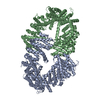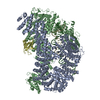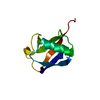[English] 日本語
 Yorodumi
Yorodumi- EMDB-10531: Structure of monoubiquitinated FANCD2 in complex with FANCI and DNA -
+ Open data
Open data
- Basic information
Basic information
| Entry | Database: EMDB / ID: EMD-10531 | |||||||||
|---|---|---|---|---|---|---|---|---|---|---|
| Title | Structure of monoubiquitinated FANCD2 in complex with FANCI and DNA | |||||||||
 Map data Map data | Post processed map from Relion | |||||||||
 Sample Sample |
| |||||||||
 Keywords Keywords | Fanconi anaemia / ubiquitin / DNA repair / DNA damage / inter-strand crosslink / DNA BINDING PROTEIN | |||||||||
| Function / homology |  Function and homology information Function and homology informationFanconi Anemia Pathway in DNA repair / Fanconi Anemia Pathway / double-strand break repair involved in meiotic recombination / homologous chromosome pairing at meiosis / mitotic intra-S DNA damage checkpoint signaling / interstrand cross-link repair / condensed chromosome / DNA polymerase binding / Maturation of protein E / Maturation of protein E ...Fanconi Anemia Pathway in DNA repair / Fanconi Anemia Pathway / double-strand break repair involved in meiotic recombination / homologous chromosome pairing at meiosis / mitotic intra-S DNA damage checkpoint signaling / interstrand cross-link repair / condensed chromosome / DNA polymerase binding / Maturation of protein E / Maturation of protein E / ER Quality Control Compartment (ERQC) / Myoclonic epilepsy of Lafora / FLT3 signaling by CBL mutants / Constitutive Signaling by NOTCH1 HD Domain Mutants / IRAK2 mediated activation of TAK1 complex / Prevention of phagosomal-lysosomal fusion / Alpha-protein kinase 1 signaling pathway / Glycogen synthesis / IRAK1 recruits IKK complex / IRAK1 recruits IKK complex upon TLR7/8 or 9 stimulation / Endosomal Sorting Complex Required For Transport (ESCRT) / Membrane binding and targetting of GAG proteins / Negative regulation of FLT3 / Regulation of TBK1, IKKε (IKBKE)-mediated activation of IRF3, IRF7 / PTK6 Regulates RTKs and Their Effectors AKT1 and DOK1 / Regulation of TBK1, IKKε-mediated activation of IRF3, IRF7 upon TLR3 ligation / IRAK2 mediated activation of TAK1 complex upon TLR7/8 or 9 stimulation / NOTCH2 Activation and Transmission of Signal to the Nucleus / TICAM1,TRAF6-dependent induction of TAK1 complex / TICAM1-dependent activation of IRF3/IRF7 / APC/C:Cdc20 mediated degradation of Cyclin B / Downregulation of ERBB4 signaling / Regulation of FZD by ubiquitination / APC-Cdc20 mediated degradation of Nek2A / p75NTR recruits signalling complexes / InlA-mediated entry of Listeria monocytogenes into host cells / TRAF6 mediated IRF7 activation in TLR7/8 or 9 signaling / TRAF6-mediated induction of TAK1 complex within TLR4 complex / Regulation of pyruvate metabolism / NF-kB is activated and signals survival / Regulation of innate immune responses to cytosolic DNA / Pexophagy / Downregulation of ERBB2:ERBB3 signaling / NRIF signals cell death from the nucleus / Regulation of PTEN localization / Activated NOTCH1 Transmits Signal to the Nucleus / VLDLR internalisation and degradation / Regulation of BACH1 activity / Synthesis of active ubiquitin: roles of E1 and E2 enzymes / MAP3K8 (TPL2)-dependent MAPK1/3 activation / Translesion synthesis by REV1 / TICAM1, RIP1-mediated IKK complex recruitment / Translesion synthesis by POLK / InlB-mediated entry of Listeria monocytogenes into host cell / Activation of IRF3, IRF7 mediated by TBK1, IKKε (IKBKE) / JNK (c-Jun kinases) phosphorylation and activation mediated by activated human TAK1 / Josephin domain DUBs / Downregulation of TGF-beta receptor signaling / Translesion synthesis by POLI / IKK complex recruitment mediated by RIP1 / Gap-filling DNA repair synthesis and ligation in GG-NER / Regulation of activated PAK-2p34 by proteasome mediated degradation / PINK1-PRKN Mediated Mitophagy / TGF-beta receptor signaling in EMT (epithelial to mesenchymal transition) / TNFR1-induced NF-kappa-B signaling pathway / Autodegradation of Cdh1 by Cdh1:APC/C / TCF dependent signaling in response to WNT / APC/C:Cdc20 mediated degradation of Securin / Regulation of NF-kappa B signaling / N-glycan trimming in the ER and Calnexin/Calreticulin cycle / activated TAK1 mediates p38 MAPK activation / Asymmetric localization of PCP proteins / Ubiquitin-dependent degradation of Cyclin D / SCF-beta-TrCP mediated degradation of Emi1 / NIK-->noncanonical NF-kB signaling / TNFR2 non-canonical NF-kB pathway / Regulation of signaling by CBL / AUF1 (hnRNP D0) binds and destabilizes mRNA / NOTCH3 Activation and Transmission of Signal to the Nucleus / Negative regulators of DDX58/IFIH1 signaling / Vpu mediated degradation of CD4 / Assembly of the pre-replicative complex / Ubiquitin-Mediated Degradation of Phosphorylated Cdc25A / Deactivation of the beta-catenin transactivating complex / Negative regulation of FGFR3 signaling / Peroxisomal protein import / Fanconi Anemia Pathway / Degradation of DVL / Dectin-1 mediated noncanonical NF-kB signaling / Cdc20:Phospho-APC/C mediated degradation of Cyclin A / Negative regulation of FGFR2 signaling / Stabilization of p53 / Negative regulation of FGFR4 signaling / Downregulation of SMAD2/3:SMAD4 transcriptional activity / Degradation of AXIN / Negative regulation of FGFR1 signaling / Regulation of TNFR1 signaling / EGFR downregulation / Hh mutants are degraded by ERAD / Termination of translesion DNA synthesis Similarity search - Function | |||||||||
| Biological species |   Homo sapiens (human) / Synthetic construct (others) / synthetic construct (others) Homo sapiens (human) / Synthetic construct (others) / synthetic construct (others) | |||||||||
| Method | single particle reconstruction / cryo EM / Resolution: 3.8 Å | |||||||||
 Authors Authors | Alcon P / Shakeel S | |||||||||
| Funding support |  United Kingdom, 2 items United Kingdom, 2 items
| |||||||||
 Citation Citation |  Journal: Nat Struct Mol Biol / Year: 2020 Journal: Nat Struct Mol Biol / Year: 2020Title: FANCD2-FANCI is a clamp stabilized on DNA by monoubiquitination of FANCD2 during DNA repair. Authors: Pablo Alcón / Shabih Shakeel / Zhuo A Chen / Juri Rappsilber / Ketan J Patel / Lori A Passmore /   Abstract: Vertebrate DNA crosslink repair excises toxic replication-blocking DNA crosslinks. Numerous factors involved in crosslink repair have been identified, and mutations in their corresponding genes cause ...Vertebrate DNA crosslink repair excises toxic replication-blocking DNA crosslinks. Numerous factors involved in crosslink repair have been identified, and mutations in their corresponding genes cause Fanconi anemia (FA). A key step in crosslink repair is monoubiquitination of the FANCD2-FANCI heterodimer, which then recruits nucleases to remove the DNA lesion. Here, we use cryo-EM to determine the structures of recombinant chicken FANCD2 and FANCI complexes. FANCD2-FANCI adopts a closed conformation when the FANCD2 subunit is monoubiquitinated, creating a channel that encloses double-stranded DNA (dsDNA). Ubiquitin is positioned at the interface of FANCD2 and FANCI, where it acts as a covalent molecular pin to trap the complex on DNA. In contrast, isolated FANCD2 is a homodimer that is unable to bind DNA, suggestive of an autoinhibitory mechanism that prevents premature activation. Together, our work suggests that FANCD2-FANCI is a clamp that is locked onto DNA by ubiquitin, with distinct interfaces that may recruit other DNA repair factors. | |||||||||
| History |
|
- Structure visualization
Structure visualization
| Movie |
 Movie viewer Movie viewer |
|---|---|
| Structure viewer | EM map:  SurfView SurfView Molmil Molmil Jmol/JSmol Jmol/JSmol |
| Supplemental images |
- Downloads & links
Downloads & links
-EMDB archive
| Map data |  emd_10531.map.gz emd_10531.map.gz | 21.2 MB |  EMDB map data format EMDB map data format | |
|---|---|---|---|---|
| Header (meta data) |  emd-10531-v30.xml emd-10531-v30.xml emd-10531.xml emd-10531.xml | 29.3 KB 29.3 KB | Display Display |  EMDB header EMDB header |
| FSC (resolution estimation) |  emd_10531_fsc.xml emd_10531_fsc.xml | 16 KB | Display |  FSC data file FSC data file |
| Images |  emd_10531.png emd_10531.png | 94.8 KB | ||
| Filedesc metadata |  emd-10531.cif.gz emd-10531.cif.gz | 8.5 KB | ||
| Others |  emd_10531_additional_1.map.gz emd_10531_additional_1.map.gz emd_10531_additional_2.map.gz emd_10531_additional_2.map.gz emd_10531_half_map_1.map.gz emd_10531_half_map_1.map.gz emd_10531_half_map_2.map.gz emd_10531_half_map_2.map.gz | 277 MB 4.4 MB 278 MB 277.3 MB | ||
| Archive directory |  http://ftp.pdbj.org/pub/emdb/structures/EMD-10531 http://ftp.pdbj.org/pub/emdb/structures/EMD-10531 ftp://ftp.pdbj.org/pub/emdb/structures/EMD-10531 ftp://ftp.pdbj.org/pub/emdb/structures/EMD-10531 | HTTPS FTP |
-Validation report
| Summary document |  emd_10531_validation.pdf.gz emd_10531_validation.pdf.gz | 775.9 KB | Display |  EMDB validaton report EMDB validaton report |
|---|---|---|---|---|
| Full document |  emd_10531_full_validation.pdf.gz emd_10531_full_validation.pdf.gz | 775.5 KB | Display | |
| Data in XML |  emd_10531_validation.xml.gz emd_10531_validation.xml.gz | 23.5 KB | Display | |
| Data in CIF |  emd_10531_validation.cif.gz emd_10531_validation.cif.gz | 31.2 KB | Display | |
| Arichive directory |  https://ftp.pdbj.org/pub/emdb/validation_reports/EMD-10531 https://ftp.pdbj.org/pub/emdb/validation_reports/EMD-10531 ftp://ftp.pdbj.org/pub/emdb/validation_reports/EMD-10531 ftp://ftp.pdbj.org/pub/emdb/validation_reports/EMD-10531 | HTTPS FTP |
-Related structure data
| Related structure data |  6tnfMC  6tngC  6tniC M: atomic model generated by this map C: citing same article ( |
|---|---|
| Similar structure data | |
| EM raw data |  EMPIAR-10611 (Title: Unaligned movies for ubFANCD2-FANCI + DNA / Data size: 4.5 TB / Data #1: Unaligned movies [micrographs - multiframe] / Data #2: Unaligned movies [micrographs - multiframe]) EMPIAR-10611 (Title: Unaligned movies for ubFANCD2-FANCI + DNA / Data size: 4.5 TB / Data #1: Unaligned movies [micrographs - multiframe] / Data #2: Unaligned movies [micrographs - multiframe]) |
- Links
Links
| EMDB pages |  EMDB (EBI/PDBe) / EMDB (EBI/PDBe) /  EMDataResource EMDataResource |
|---|---|
| Related items in Molecule of the Month |
- Map
Map
| File |  Download / File: emd_10531.map.gz / Format: CCP4 / Size: 347.6 MB / Type: IMAGE STORED AS FLOATING POINT NUMBER (4 BYTES) Download / File: emd_10531.map.gz / Format: CCP4 / Size: 347.6 MB / Type: IMAGE STORED AS FLOATING POINT NUMBER (4 BYTES) | ||||||||||||||||||||||||||||||||||||||||||||||||||||||||||||
|---|---|---|---|---|---|---|---|---|---|---|---|---|---|---|---|---|---|---|---|---|---|---|---|---|---|---|---|---|---|---|---|---|---|---|---|---|---|---|---|---|---|---|---|---|---|---|---|---|---|---|---|---|---|---|---|---|---|---|---|---|---|
| Annotation | Post processed map from Relion | ||||||||||||||||||||||||||||||||||||||||||||||||||||||||||||
| Projections & slices | Image control
Images are generated by Spider. | ||||||||||||||||||||||||||||||||||||||||||||||||||||||||||||
| Voxel size | X=Y=Z: 1.06 Å | ||||||||||||||||||||||||||||||||||||||||||||||||||||||||||||
| Density |
| ||||||||||||||||||||||||||||||||||||||||||||||||||||||||||||
| Symmetry | Space group: 1 | ||||||||||||||||||||||||||||||||||||||||||||||||||||||||||||
| Details | EMDB XML:
CCP4 map header:
| ||||||||||||||||||||||||||||||||||||||||||||||||||||||||||||
-Supplemental data
-Additional map: Refined map
| File | emd_10531_additional_1.map | ||||||||||||
|---|---|---|---|---|---|---|---|---|---|---|---|---|---|
| Annotation | Refined map | ||||||||||||
| Projections & Slices |
| ||||||||||||
| Density Histograms |
-Additional map: Focussed map for DNA region. Please use this...
| File | emd_10531_additional_2.map | ||||||||||||
|---|---|---|---|---|---|---|---|---|---|---|---|---|---|
| Annotation | Focussed map for DNA region. Please use this map for DNA model fit in map. | ||||||||||||
| Projections & Slices |
| ||||||||||||
| Density Histograms |
-Half map: Half2 map from auto-refinement in Relion
| File | emd_10531_half_map_1.map | ||||||||||||
|---|---|---|---|---|---|---|---|---|---|---|---|---|---|
| Annotation | Half2 map from auto-refinement in Relion | ||||||||||||
| Projections & Slices |
| ||||||||||||
| Density Histograms |
-Half map: Half1 map from auto-refinement in Relion
| File | emd_10531_half_map_2.map | ||||||||||||
|---|---|---|---|---|---|---|---|---|---|---|---|---|---|
| Annotation | Half1 map from auto-refinement in Relion | ||||||||||||
| Projections & Slices |
| ||||||||||||
| Density Histograms |
- Sample components
Sample components
-Entire : Complex of monoubiquitinated FANCD2, FANCI and DNA
| Entire | Name: Complex of monoubiquitinated FANCD2, FANCI and DNA |
|---|---|
| Components |
|
-Supramolecule #1: Complex of monoubiquitinated FANCD2, FANCI and DNA
| Supramolecule | Name: Complex of monoubiquitinated FANCD2, FANCI and DNA / type: complex / ID: 1 / Parent: 0 / Macromolecule list: all |
|---|---|
| Molecular weight | Theoretical: 300 KDa |
-Supramolecule #2: FANCD2, FANCI
| Supramolecule | Name: FANCD2, FANCI / type: complex / ID: 2 / Parent: 1 / Macromolecule list: #1-#2 |
|---|---|
| Source (natural) | Organism:  |
-Supramolecule #3: UBC
| Supramolecule | Name: UBC / type: complex / ID: 3 / Parent: 1 / Macromolecule list: #3 |
|---|---|
| Source (natural) | Organism:  Homo sapiens (human) Homo sapiens (human) |
-Supramolecule #4: DNA
| Supramolecule | Name: DNA / type: complex / ID: 4 / Parent: 1 / Macromolecule list: #4 Details: An idealized dsDNA of 33 bp of arbitrary sequence was placed and refined into the EM density but the following DNA sequences were used in the sample preparation by annealing oligonucleotides ...Details: An idealized dsDNA of 33 bp of arbitrary sequence was placed and refined into the EM density but the following DNA sequences were used in the sample preparation by annealing oligonucleotides X1, X2, X3, X4, X5, X6: X1: GCGCACCAAGAGATACGCGGTCGAATGCCGAGTAGCCATCAGCG X2: ACCATGCAGCTACTCGGCATTCGACCGCGTATCTGGCGACTACG X3: TATCTCTTGGTGCGC X4: CGCTGATGGCTACTC X5: CGTAGTCGCCAGATA X6: GAGTAGCTGCATGGT |
|---|---|
| Source (natural) | Organism: Synthetic construct (others) |
-Macromolecule #1: FANCD2
| Macromolecule | Name: FANCD2 / type: protein_or_peptide / ID: 1 / Number of copies: 1 / Enantiomer: LEVO |
|---|---|
| Source (natural) | Organism:  |
| Molecular weight | Theoretical: 160.932328 KDa |
| Recombinant expression | Organism:  |
| Sequence | String: MVSKRKLSKI DAAEESSKTD LQSRCPETKR SRISDKRAPS QGGLENEGVF EELLRTSGII LKVGEGQNEI AVDQTAFQKK LRVALEKHP SYPGVVNEFI SGLESHIKDR SQFKNCLLPC TPARTEGSRT LVHSYCESLI KLLLGIKILQ PAVVTLLLEK I PEFFFDVV ...String: MVSKRKLSKI DAAEESSKTD LQSRCPETKR SRISDKRAPS QGGLENEGVF EELLRTSGII LKVGEGQNEI AVDQTAFQKK LRVALEKHP SYPGVVNEFI SGLESHIKDR SQFKNCLLPC TPARTEGSRT LVHSYCESLI KLLLGIKILQ PAVVTLLLEK I PEFFFDVV GTFGTNFPRL IVNQFKWLDG LLDSQDLVKK LMQMLSVSPV PIQHDIITSL PEILEDSQQN EVARELSCLL KQ GRRLTVP ILDALSRLDL DAELLAKVRQ SAMTIVPSVK LEDLPVVIKF ILHNVKAADA VEVISDLRKS LDLSSCVLPL QLL GSQRKL KSQAQASSSM SQVTTSQNCV KLLFDVIKLA VRFQKDVSEA WIKAIENSTS VSDHKVLDLI VLLLIHSTNS KNRK QTEKV LRSKIRLGCM PEQLMQNAFQ NHSMVIKDFF PSILSLAQTF LHSAHPAVVS FGSCMYKQAF AVFDSYCQQE VVCAL VTHV CSGNETELDI SLDVLTDLVI LHPSLLLRYA TFVKTILDSM QKLNPCQIRK LFYILSTLAF SQRQEGSYIQ DDMHMV IRK WLSSSVPNHK QMGIIGAVTM MGSVALKRNE ADGGLLERPE LSIECDGQLS TLLDLVGFCC EQTPEVLALY YDELANL IE KQKGNLDLQL LDKFGKSLVE DFPNDFVVDL SPTVDGSFLF PVKSLYNLDE DETQGAIAIN LLPLVSQSEP GRVADEMS N SRKRVVSPIC LSPCFRLLRL YTGEQNNGSL EEIDALLGCP LYLTDLEVEG KLDSLSKQER EFLCSLLFYA LNWFREVVN AFCQQQDAEM KGKVLTRLQN ITELQNVLGK CLAATPGYVP PPATFDSEAP EGVPSINAGG PVRKKNGKKR KSDSSKACSA ERTQADESS DGNQPDTELS ELEKSAAEKE TGNPLAQLQS YRPYFRELDL EVFSVLHCGL LTKSILDTEM HTEASEVVQL G PAELCFLL DDMCWKLEHV LTPGSTRRVP FLKERGNKDV GFSHLCQRSP KEVAVCVVKL LKPLCNHMEN MHNYFQTVIP NQ GVVDESG LNIQEYQLMS SCYHQLLLAF RLLFAWSGFS QHENSNLLRS ALQVLADRLK PGETEFLPLE ELISESFQYL LNF QASIPS FQCAFILTQV LMAISEKPMT GWKREKMASL AKQFLCQSWM KPGGDREKGS HFNSALHTLL CVYLEHTDNI LKAI EEISS VGVPELINSA KDGCSSTYPT LSRQTFPVFF RVMMAQLESS VKSIPAGKPS DSGEVQLEKL LKWNIAVRNF HILIN LVKV FDSRPVLSIC LKYGRLFVEA FLKLAMPLLD HSFKKHRDDV QSLLKTLQLS TRQLHHMCGH SKIHQDLGLT NHVPLL KKS LEQFVYRVKA MLAFNHCQEA FWVGVLKNRD LQGEEILSQA SAAPEEDSAE GSEEDTEDSA AEEPDGTDSD SGGAGR UniProtKB: Fanconi anemia complementation group D2 |
-Macromolecule #2: Fanconi anemia complementation group I
| Macromolecule | Name: Fanconi anemia complementation group I / type: protein_or_peptide / ID: 2 / Number of copies: 1 / Enantiomer: LEVO |
|---|---|
| Source (natural) | Organism:  |
| Molecular weight | Theoretical: 149.458297 KDa |
| Recombinant expression | Organism:  |
| Sequence | String: MAQRILQLAA EGSPERLQEA LQGLTEGELG DMVTRQALRG RETAALLKGI FKGSPCSQQS GVLRRLQVYK HCVSLVESGD LHVGKVSEI IGLLMLEARQ LPGHALAELA TLFVEVIKRG SLSNGKSLEL FSTVLTALSN SKESLAYGKG ELNGEEFKKQ L INTLCSSK ...String: MAQRILQLAA EGSPERLQEA LQGLTEGELG DMVTRQALRG RETAALLKGI FKGSPCSQQS GVLRRLQVYK HCVSLVESGD LHVGKVSEI IGLLMLEARQ LPGHALAELA TLFVEVIKRG SLSNGKSLEL FSTVLTALSN SKESLAYGKG ELNGEEFKKQ L INTLCSSK WDPQCVIHLA NMFRDIPLSG EELQFVVEKV LRMFSKLDLQ EIPPLVYQLL LLSAKGSKKT VLEGIISFFN QL DKRQKEE QRVPQSADLE VATVPLDQLR HVEGTVILHI VSAINLDQDI GEELIKHLKT EQQKDPGKAL CPFSVSLLLS TAV KHRLQE QIFDFLKTSI TRSCKDLQIL QASKFLQDLC PQQYDVTAVI LEVVKNSAFG WDHVTQGLVD LGFSLMESYE PKKS FGGKA AETNLGLSKM PAQQACKLGA SILLETFKVH EPIRSDILEQ VLNRVLTKAA SPVSHFIDLL SNIVVSAPLV LQNSS SRVT ETFDNLSFLP IDTVQGLLRA VQPLLKVSMS VRDSLILVLQ KAIFSRQLDA RKAAVAGFLL LLRNFKILGS LTSSQC SQA IGATQVQADV HACYNSAANE AFCLEILGSL RRCLSQQADV RLMLYEGFYD VLRRNSQLAS SIMETLLSQI KQYYLPQ QD LLPPLKLEGC IMAQGDQIFL QEPLAHLLCC IQHCLAWYKS TVHLCKGAED EEEEEDVGFE QNFEEMLESV TRRMIKSE L EDFELDKSAD FSPSSGVGVK NNIYAIQVMG ICEVLIEYNF KIGNFSKNKF EDVLGLFTCY NKLSEILKEK AGKNKSTLG NRIARSFLSM GFVSTLLTAL FRDNAQSHEE SLAVLRSSTE FMRYAVSVAL QKVQQLEEMG QTDGPDGQNP EKMFQNLCKI TRVLLWRYT SIPTAVEESG KKKGKSISLL CLEGLLRIFN TMQQLYAARI PQFLQALDIT DGDAEEADIN VTEKAAFQIR Q FQRSLVNQ LSSAEDDFNS KETQLLITIL STLSKLLDPG SQQFLQFLTW TVKICKENAL EDLSCCKGLL TLLFSLHVLY KS PVSLLRE LAQDIHACLG DIDQDVEIES RSHFAIVNVK TAAPTVCLLV LGQADKVLEE VDWLIKRLTI LGSDTSEDST QAS NQTQAL EKGVILQLGT LLTVFHELVQ TALPAGSCVD SLLRSLSKTY AILTSLIKHY IQACRSTSNT VPGRLEKLVK LSGS HLTPQ CYSFITYVQN IHSESLSFAE EKKKKKKEDE TAVVSTVMAK VLRDTKPIPN LIFAIEQYEK FLIHLSKKSK VNLMQ YMKL STSRDFRINA SMLDSVLQEQ NTEDAENEPD NNQSGTAEQP DENQEPQKKR RRKK UniProtKB: Fanconi anemia group I protein |
-Macromolecule #3: Polyubiquitin-C
| Macromolecule | Name: Polyubiquitin-C / type: protein_or_peptide / ID: 3 / Number of copies: 1 / Enantiomer: LEVO |
|---|---|
| Source (natural) | Organism:  Homo sapiens (human) Homo sapiens (human) |
| Molecular weight | Theoretical: 8.576831 KDa |
| Recombinant expression | Organism:  |
| Sequence | String: MQIFVKTLTG KTITLEVEPS DTIENVKAKI QDKEGIPPDQ QRLIFAGKQL EDGRTLSDYN IQKESTLHLV LRLRGG UniProtKB: Polyubiquitin-C |
-Macromolecule #4: DNA (33-MER)
| Macromolecule | Name: DNA (33-MER) / type: dna / ID: 4 Details: An idealized dsDNA of 33 bp of arbitrary sequence was placed and refined into the EM density but the following DNA sequences were used in the sample preparation by annealing oligonucleotides ...Details: An idealized dsDNA of 33 bp of arbitrary sequence was placed and refined into the EM density but the following DNA sequences were used in the sample preparation by annealing oligonucleotides X1, X2, X3, X4, X5, X6: X1: GCGCACCAAGAGATACGCGGTCGAATGCCGAGTAGCCATCAGCG X2: ACCATGCAGCTACTCGGCATTCGACCGCGTATCTGGCGACTACG X3: TATCTCTTGGTGCGC X4: CGCTGATGGCTACTC X5: CGTAGTCGCCAGATA X6: GAGTAGCTGCATGGT Number of copies: 2 / Classification: DNA |
|---|---|
| Source (natural) | Organism: synthetic construct (others) |
| Molecular weight | Theoretical: 5.898203 KDa |
| Sequence | String: (DN)(DN)(DN)(DN)(DN)(DN)(DN)(DN)(DN)(DN) (DN)(DN)(DN)(DN)(DN)(DN)(DN)(DN)(DN)(DN) (DN)(DN)(DN)(DN)(DN)(DN)(DN)(DN)(DN) (DN)(DN)(DN)(DN) |
-Experimental details
-Structure determination
| Method | cryo EM |
|---|---|
 Processing Processing | single particle reconstruction |
| Aggregation state | particle |
- Sample preparation
Sample preparation
| Concentration | 0.3 mg/mL |
|---|---|
| Buffer | pH: 8 Details: 50 mM HEPES, 100 mM imidazole, 150 mM NaCl, 1 mM TCEP |
| Grid | Model: UltrAuFoil / Material: GOLD / Mesh: 300 / Pretreatment - Type: PLASMA CLEANING / Pretreatment - Time: 25 sec. |
| Vitrification | Cryogen name: ETHANE / Chamber humidity: 100 % / Chamber temperature: 277.15 K / Instrument: FEI VITROBOT MARK IV |
- Electron microscopy
Electron microscopy
| Microscope | FEI TITAN KRIOS |
|---|---|
| Specialist optics | Energy filter - Slit width: 20 eV |
| Image recording | Film or detector model: GATAN K3 BIOQUANTUM (6k x 4k) / Average electron dose: 70.0 e/Å2 |
| Electron beam | Acceleration voltage: 300 kV / Electron source:  FIELD EMISSION GUN FIELD EMISSION GUN |
| Electron optics | C2 aperture diameter: 50.0 µm / Illumination mode: FLOOD BEAM / Imaging mode: BRIGHT FIELD / Cs: 2.7 mm / Nominal defocus max: 3.5 µm / Nominal defocus min: 1.8 µm / Nominal magnification: 81000 |
| Sample stage | Specimen holder model: FEI TITAN KRIOS AUTOGRID HOLDER / Cooling holder cryogen: NITROGEN |
| Experimental equipment |  Model: Titan Krios / Image courtesy: FEI Company |
 Movie
Movie Controller
Controller































 Z (Sec.)
Z (Sec.) Y (Row.)
Y (Row.) X (Col.)
X (Col.)
























































